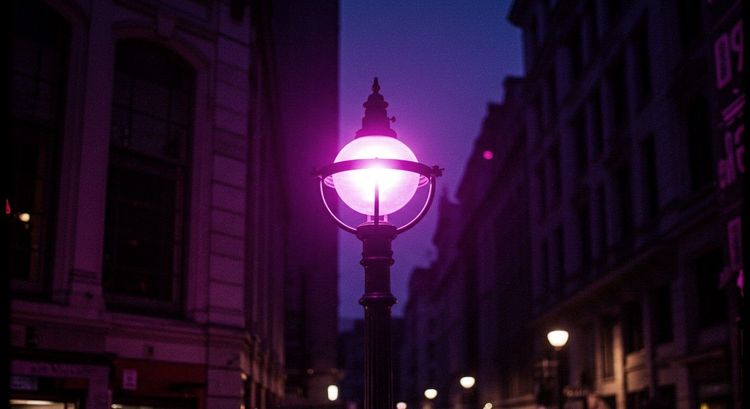
Light-emitting diodes (LEDs) are the most energy-efficient lighting technology available today. They last longer, disperse light effectively, and their brightness can be dimmed, which reduces light pollution and saves energy.
Cities are actively switching to LED lighting. For instance, Bristol is installing 29,000 LED lights without replacing the poles, aiming to complete the work by the end of 2025 [1]. New South Wales, Australia, has already installed 217,000 LED lights as part of its smart street lighting program [2]. Philadelphia, USA, is also transitioning to LED lights, with over 80% of the planned work completed, and a recent study (May 2025) has already shown a 21% decrease in street crimes involving firearms [3].
LED lights shine brightly, enhancing visibility and deterring offenders. But what happens if an LED light starts emitting purple light?
Purple light from street LED lights: this shouldn’t happen
If an LED light starts emitting purple light, it’s not a design choice but a result of a manufacturing defect in the light fixture.
LEDs themselves do not emit white light; they can produce red, green, yellow, or blue light. White LED lighting is created by mixing different wavelengths of light. Blue light from a blue diode passes through a phosphor layer. This fluorescent material absorbs some of the blue light and converts it into red and yellow. Consequently, the three colors (blue, red, and yellow) mix, and we see white light.
Unusual purple light is a direct indication of a defect. The issue occurs when the phosphor coating on the LED chips is damaged: small cracks appear, layers peel off, or, in the worst case, the chips are completely exposed. When the phosphor peels off, it ceases to convert the blue light, allowing it to escape and mix with the remaining light, resulting in a purple hue.
Such defective lights can be part of large batches supplied to utility services. For instance, the Canadian utility company Manitoba Hydro reported similar purple street lights in Vancouver, several U.S. states, and the UK [4].
Is this a problem? Yes.
Purple street light is unsafe for drivers and pedestrians. Proper color rendering of lighting is crucial for object recognition. Intense blue and purple light impairs the eyes’ ability to distinguish details since the center of the retina lacks cells sensitive to blue light. Moreover, a high proportion of blue light from street lights is detrimental to human health [5].
Consequently, lighting that initially met industry and national standards no longer complies. Preventing purple glow once the defect has appeared is impossible. The only solution is to replace the defective light fixture, which incurs additional costs and diminishes trust in urban modernization projects.
How to prevent the problem of purple LED light
To completely eliminate purple glow in street lights, a comprehensive approach to the lighting project is necessary, beginning from the earliest planning stages.
The LED chips used in street lights must undergo rigorous testing according to the LM-80 standard, which confirms their color stability and compliance with requirements. Additionally, request test reports for LED chips to ensure the reliability and durability of the lamps [6].
Select suppliers who provide a warranty covering defects caused by manufacturing flaws. This will enable free replacement of faulty lamps.
Conclusion
Smart street lighting: beyond just light
Street LED lamps offer numerous advantages, but they alone do not address all the challenges faced by municipalities. This is where Qulon street lighting systems come in, delivering high performance and reliability, and unlocking the full potential of LEDs.
For instance, the Zhaga lighting controller, operating via GSM, features a built-in accelerometer that monitors the condition of the poles, preventing on-site breakdowns. At the zone and district level, the monitoring system offers highly accurate tracking of energy consumption parameters, flexible lighting schedule settings, analytics for further energy savings, and preventive maintenance.
Street Light Controller QULON C1
Street Light Controller QULON C1 is designed for remote diagnostics and control of street lighting systems.
For two-way communication with other devices and meters, Street Light Controller QULON C1 uses RS-485 interfaces. A 2G cellular connection is used to communicate with the QULON server.
The unit is powered from 110/220 V AC or 9-36 V DC.
The Street Light Controller QULON C1 can be configured remotely using the QULON control system and the DIP switches on the unit.
The unit is designed for DIN rail mounting in a lighting control cabinet.
Street Light Controller QULON C2
Street Light Controller QULON C2 is the central controller of the QULON control system. It is designed to provide remote monitoring and control of all electrical equipment in the lighting control cabinet: magnetic starters, QULON system accessories, etc.
Street Light Controller QULON C2 uses RS-485 or CAN interfaces for two-way communication with other devices and meters. A 2G/3G/4G cellular or 10/100 Base TX Ethernet wired connection is used to communicate with the QULON server. The unit is equipped with a GPS module for time synchronization and geo-positioning.
The unit is powered from 110/220 V AC or 9-36 VDC.
Street Light Controller QULON C2 is remotely configurable using the QULON control system and the DIP switches on the unit.
The unit is designed for DIN rail mounting in a lighting control cabinet.
